Micro-Trains Line Friendship Train 40-Foot Boxcar
Published: 2025-04-01 - By: CNW400
Last updated on: 2025-02-25
Last updated on: 2025-02-25
visibility: Public - Headline
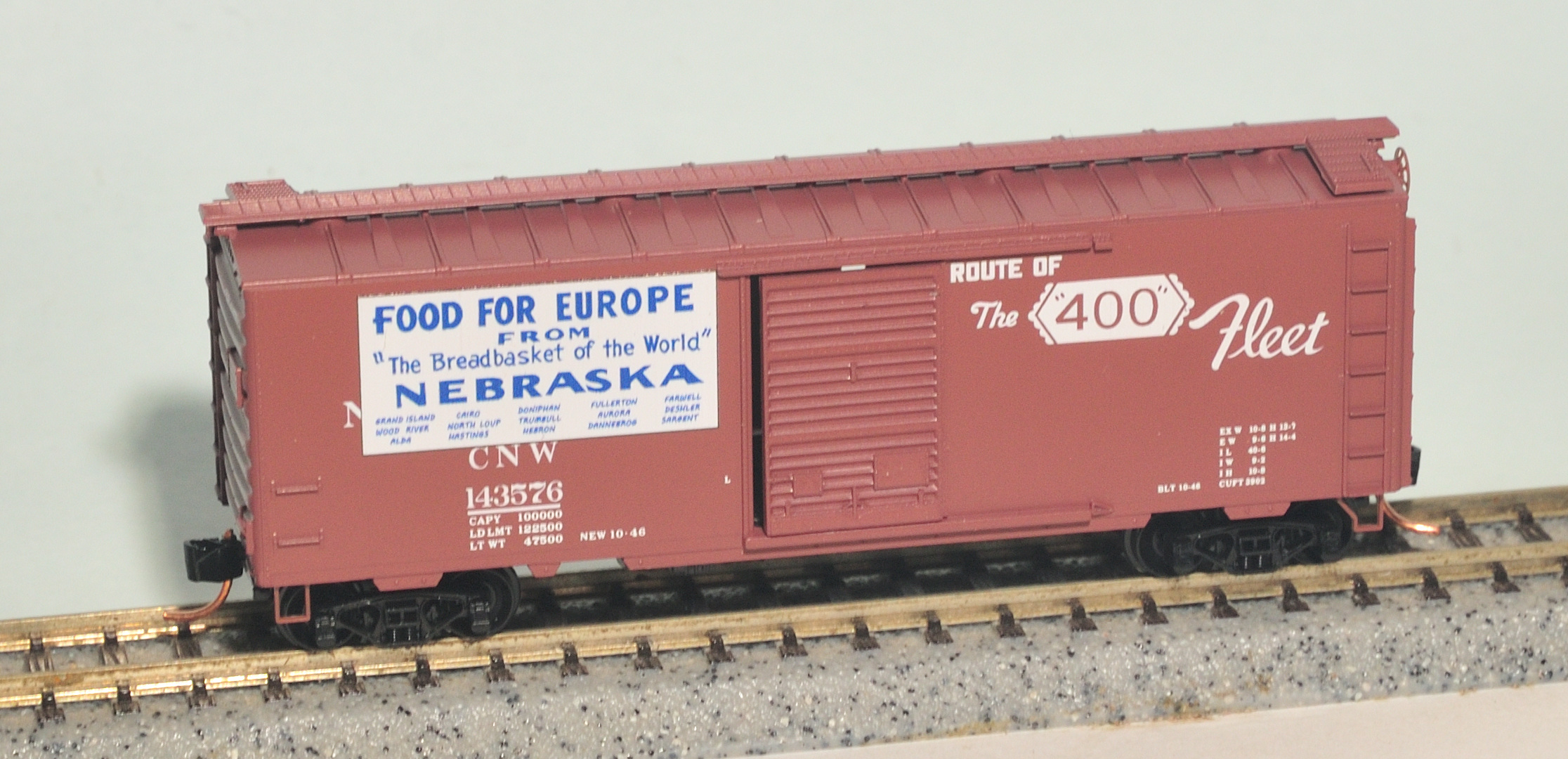
Vive la France…Viva l’Italia
May 8, 1945, marked the official end of World War II in Europe with Nazi Germany’s unconditional surrender to the Allies by Field Marshall Wilhelm Keitel in Berlin. Victory in Europe Day, or V-E Day, started the healing for war-torn Western Europe.Fast-forward two years to 1947, and Europe was still struggling to restore its economies. As both a goodwill gesture and political strategy, Washington DC journalist, nationwide syndicated columnist, and radio host Drew Pearson, devised a plan to feed the hungry people of France and Italy. Pearson suggested in his daily column ‘The Merry-Go-Round’, that the United States should donate food, medicine, supplies, and cash to Western Europe after a summer trip to Europe in 1947. There he watched as the Communist Party – lead by the Soviet Union – distribute sacks of grain and flour to the starving people of Western Europe.
Thus, on his return to America in October, Drew (along with his wife Luvie Pearson), purposed the idea of a train traveling across the country West to East. And as a sign of ‘friendship’, the citizens of the United States would donate gifts to be shipped to the struggling peoples in Europe. Pearson urged Americans to donate from “their homes, kitchens, gardens, and fields.” President Harry S Truman quickly supported the idea, citing the Truman Doctrine and Marshall Plan – both established to prevent communism from spreading within Europe and to assist in creating a democracy form of government.
Within a month of Pearson’s appeal, a train was set to leave Los Angeles on November 7, 1947. Named the ‘Friendship Train’, fourteen cars were scheduled to travel over 3,000 miles through twelve states (California-Nevada-Utah-Wyoming-Nebraska-Iowa-Illinois-Indiana-Ohio-Pennsylvania-New Jersey-New York) within two weeks…hoping to collect 80 car loads of food. Food items had to be easy to transport – requested in sacks of 100-pounds or packed in wooden crates of 24 boxes or cans.
Amongst the initial fourteen cars leaving California were two heavyweight Pullman passenger cars, a 50-foot flatcar with Hollywood-style Klieg search lights, and six brilliantly painted theme boxcars. The balance were boxcars adorned with banners celebrating the event.
The idea was met with great fanfare…America rose to the occasion to help their friends across the ocean. Schools, clubs, and businesses held contests of who could collect the most food and money. States that were not part of the route sent boxcars, reefers, and/or trucks to meet the Friendship Train along its path. These boxcars were proudly decorated announcing the gifts inside and from which area the donation was received…Raisins from Fresno – Rice from Arkansas…just to name a few. Two additional trains joined the charity event hitting areas in the northern and southern states.
Furthermore, all costs and labor associated with the event were donated by the railroad and shipping companies. The Friendship Train was given free travel and the right of way on all lines. All fuel and labor to run the trains, load and unload both ship & train, and any supplemental labor was complimentary.
Once the journey was complete on November 18, eleven days after its departure – the trip grew to three trains with 270 freight cars hauling an estimated $40 million worth of food and supplies. A crowd of over 25,000 people welcomed the trains arrival at New York City. A ticker tape parade was thrown in celebration, and several boxcars were loaded onto barges with a procession in the New York Harbor sailing past the Statue of Liberty.
All collected food was divided amongst several ships – the first shipload left for Le Havre, France on December 7, 1947, aboard the ship the American Leader – rechristened as the Friend Ship prior to its departure. All barges and ships involved with the transportation and distribution of food and supplies were decorated with banners announcing the gifts from America. Every crate and box were accompanied with a gift tag and personal message for its donor in both French and Italian with an image of the American flag. It was important to Pearson that the people of Europe knew that these gifts of generosity were from the citizens of America. The second ship left New York for Naples, Italy a week later.
Once in Italy and France, the donations were transported on ‘Friendship Trains’. Each destination hosted a ceremony that Drew Pearson made certain were covered by local newspapers as front-page news. European movie theaters also previewed short newsreels highlighting the Friendship Train’s story and journey from the United States.
The nations of Austria, Germany, Greece, and Norway also benefitted from Friendship Train donations.
As a token of gratitude and appreciation, French railroad worker Andre Picard, devised the concept of the Merci Train. A total of 49 World War I era boxcars were to be delivered to the United States. Each boxcar was filled with tokens of thanks to the American people. Over five tons of gifts were received - letters, toys, dolls, statues, clothes, handmade crafts, and more arrived on the French ship Magellan in New York Harbor on February 2, 1949. Each state was gifted one the boxcars, while Washington DC and the Territory of Hawaii shared the 49th car.

The wooden boxcars were called ‘forty and eights’ --- referring to the wartime carrying capacity of forty men and eight horses. Amongst symbols representing the different regions of France, each Merci Train boxcar was decorated with the official Merci symbol – a French Flag and a steam engine with flowers mounted on the pilot…symbolic of the 368 American soldiers that gave their lives liberating Belgium during World War I and buried at Flanders Field. Forty-three of the Merci Train boxcars still survive today – mostly in museum and historical society collections.
Pricing & Road Names
The Micro-Trains Line ‘Friendship Train’ series released a new piece of prototypical rolling stock each month from February 2017 thru January 2018. In all, 15 models are available in this collection – 12 pieces released individually, and a three-piece box set. No locomotive was created for this series. All models had a suggested retail price of $26.95. The box set was issued in January 2018 with a price tag of $89.95.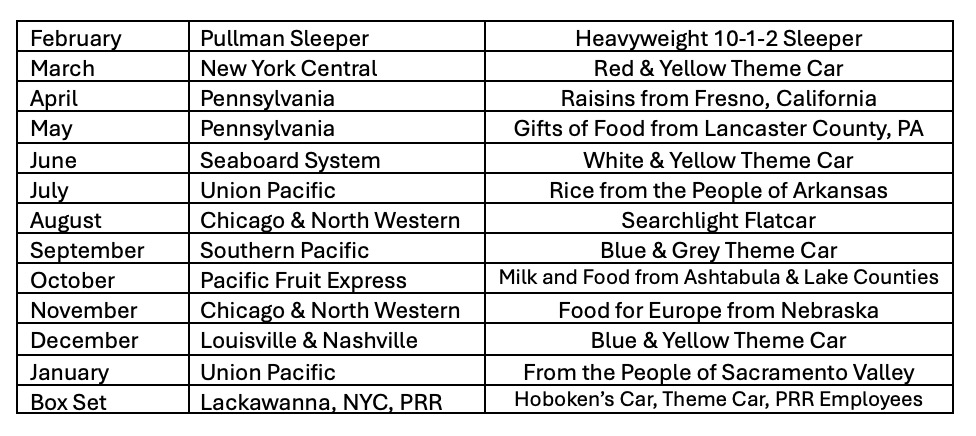
My review includes observations of ‘Friendship Boxcars’: Chicago & North Western #143576 (020 00 037) and Louisville & Nashville #16576 (020 00 057).
The Model
The Micro-Trains Line ‘Friendship Boxcars’ came packaged in a clear jewel case with a slip-off cover and one-piece plastic holder to support the model. A plastic insert protected the exposed surface from any scuffmarks. A sepia-tone image of the Los Angeles departure ceremony graces the inside of the case. The model information is neatly labeled on the end of the case, and a brief description of the prototype is found on the bottom panel. No additional parts found in the cases.
The paint jobs are bright and clean along the entire injection molded plastic bodies. All lettering and images are neat and sharp. There were two primary paint schemes for the Friendship Train. First, a series of six ‘Friendship Theme’ cars were painted in a bright, colorful two-color pattern featuring red, blue, white, and/or yellow. The sliding doors were painted in an Americana horizontal arrangement of red, white, and blue with the words ‘Friendship Train’ stenciled on the door. The two official charity drive symbols were painted on the cars – a motif with the American, French, and Italian flags and another crest representing the hands of the three nations joining together. The sentiments of “The Hearts of the American People – Food for Our Friends” and ‘Vive La France” and “Viva L’ Italia’ banners adorned the sides. Micro-Trains Line faithfully reproduced each design when compared to color images from the food collection event.

The balance of the train were mostly standard painted boxcars and reefer cars from the local railroads of the communities donating products. These cars proudly announced WHO and WHAT was donated to the food drive – the range of craftsmanship of these pronouncements were from sloppily applied signage on the car sides to professional created banners to beautiful works of car panel art. Micro-Trains has also chosen a fine assortment of these cars for their ‘Friendship Train’ Series to show to vast differences of car embellishments. It is important to note that not all rolling stock were PS-1 boxcars, but rather a large array of different boxcar and refrigerator car types.
The Micro-Train models exhibit the correct Pullman-Standard 40-foot PS-1 boxcar 5x5 panel sections on each side of the door and proper PS-1 side sills. The single door boxcars feature a Youngstown sliding door with a 4/5/5 ribbed pattern and appropriate latches and handles. The operating sliding doors reveal the interior of the boxcar with a diecast black floor exhibiting a simulated vertical wood panel floor design. Molded full length ladder and grab irons are found near each car end. Impressively applied are the prototype correct separate foot stirrup profiles – the rectangular shaped under the grab irons and the more triangular shape under the ladder.
The boxcars feature Pullman-Standard Improved 4/5 Dreadnaught non-tapering steel ends with six rectangles in the hat section. These six distinctive indentations were introduced in the early 1950s and were unique to Pullman built car ends. Both ends display prototypical correct molded full-length ladder, two grab irons, and a high-mounted placard board. The B-end is equipped with a separately applied Ajax model 3059 hand brake (used from 1929 to the early 1950s) and molded brake rods, brake chain, and brake platform. Road markings are neatly stamped on the top right corner of each car end.
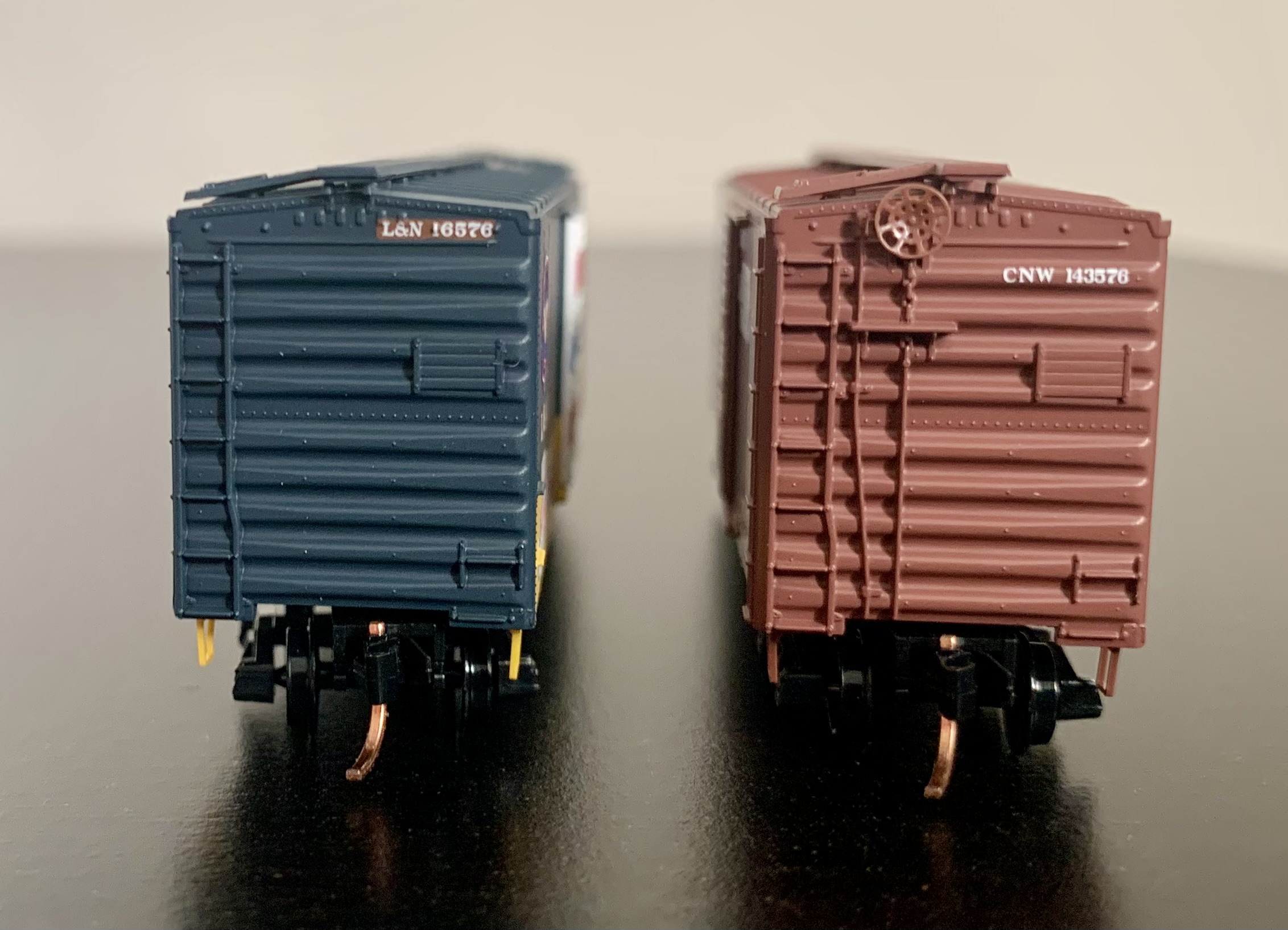
The 12-panel metal roof features the Pullman-Standard proprietary ‘bowtie’ pattern with an extended Tri-Lok or Kerrigan-style running board with laterals and corner grab irons. The open pattern of the running boards and slightly peaked roof allowed water, ice, and snow to drain more quickly.
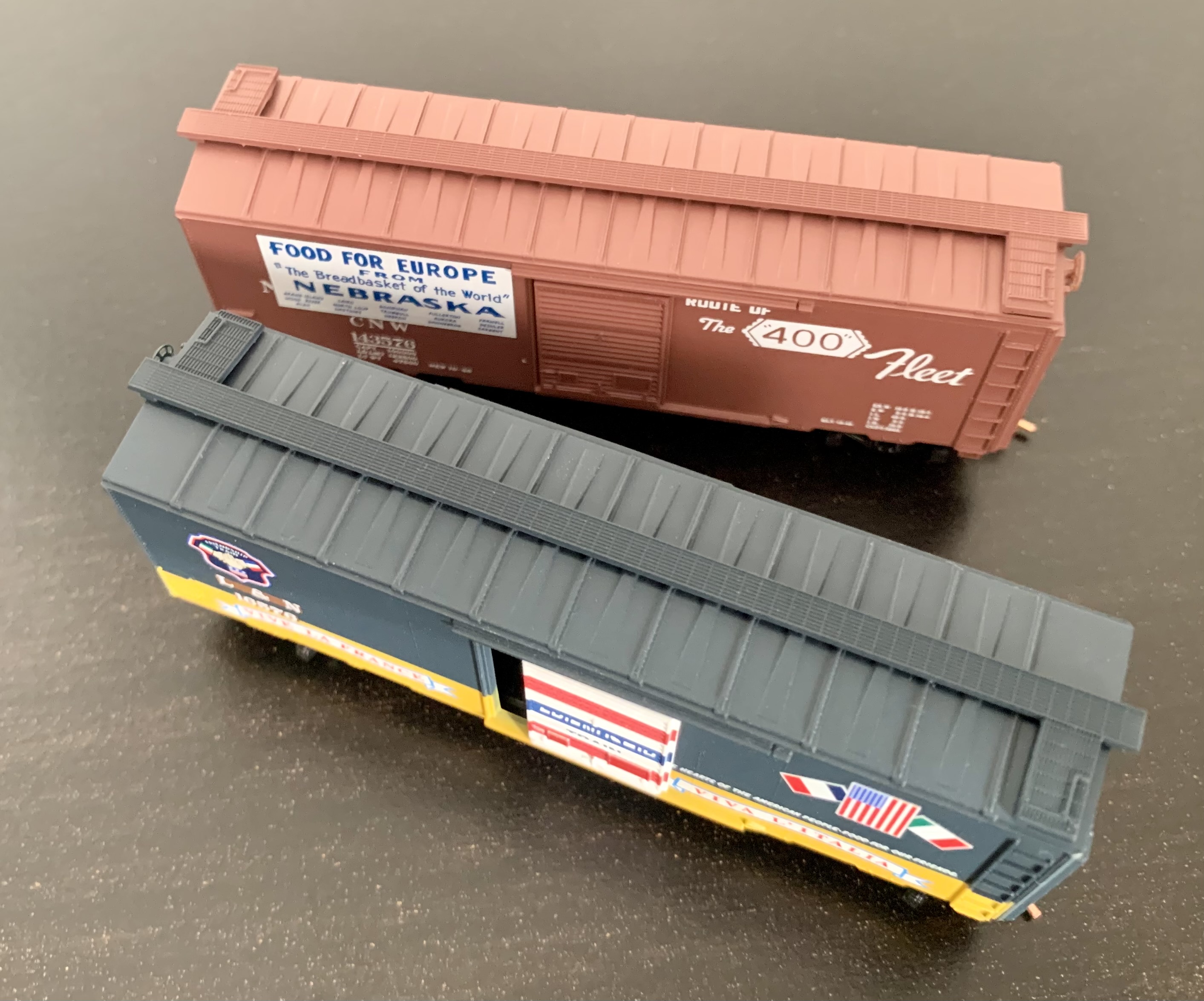
The black underframes feature an AB brake system with a cylinder, reservoir, control valve, brake rod, and cross bearer supports. The boxcars ride along Bettendorf trucks with black plastic wheels and truck-mounted Magne-Matic magnetic knuckle couplers.
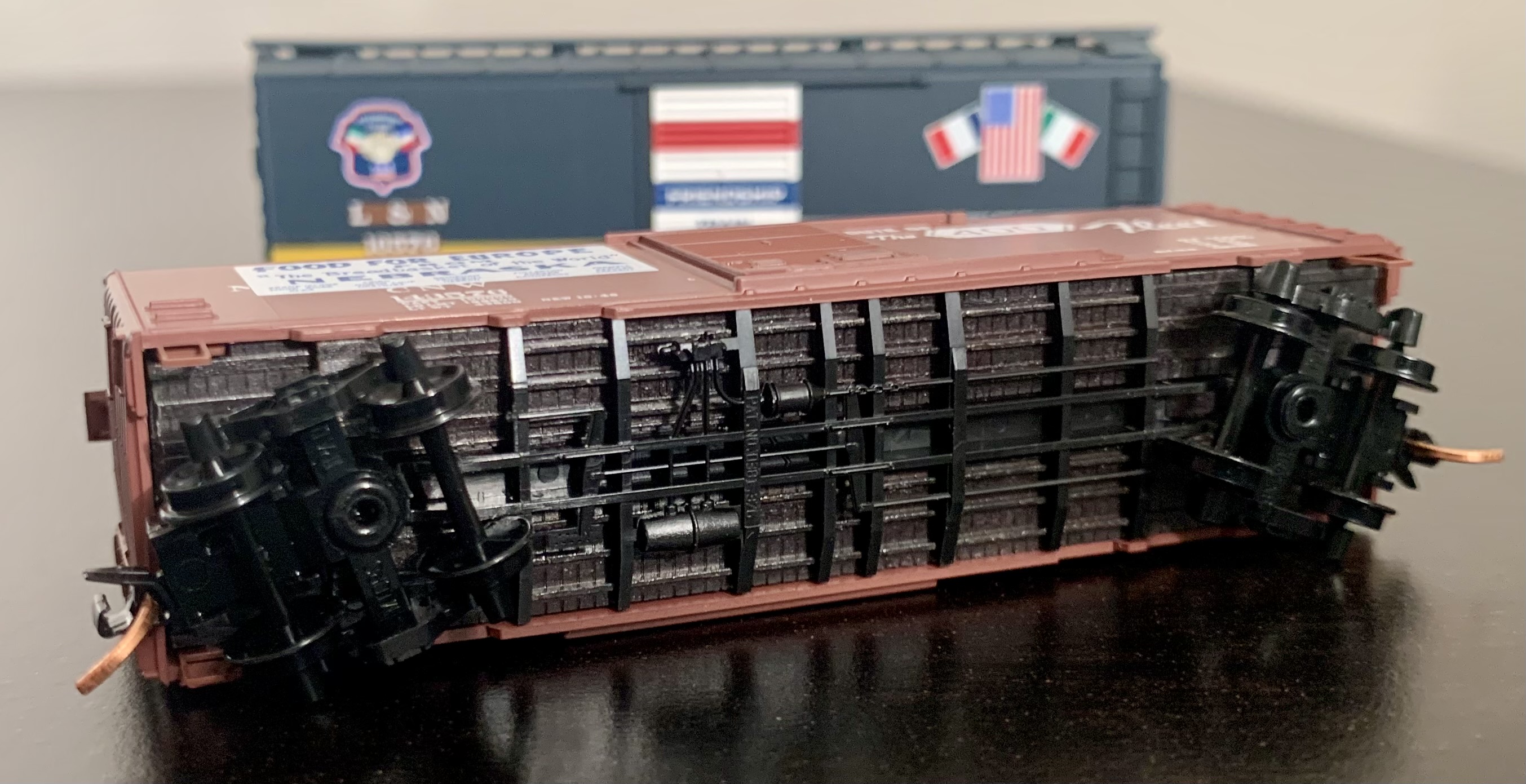
The boxcars measure 3 1/8 inches in length and weigh 0.70 ounces, which is underweight according to the National Model Railroad Association (NMRA) recommendations of 0.99 ounces for a car of this size. But I never experienced issues with Micro-Train boxcars while running the models on Kato Unitrack at slow and medium speeds. If desired, the operating doors allow for additional weight to be added easily.
Excellent subject matter by Micro-Trains Line…I enjoyed researching the history of the ‘Friendship Train’ and appreciate the attention to graphic elements Micro-Trains provided to this series. Yes, for the purist – the collection does not offer the correct type of boxcar or detail parts found on the real-life pieces of rolling stock. A basic PS-1 boxcar model fills most of the inventory in this collection, but in my opinion, the story behind these models is what is important. A quality-built model, that runs great, and harkens back to a time when America was happy to be your friend.

